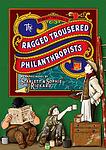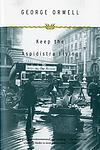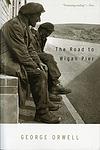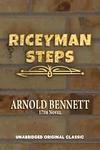The Greatest British "Poverty" Books of All Time
Click to learn how this list is calculated.
This list represents a comprehensive and trusted collection of the greatest books. Developed through a specialized algorithm, it brings together 300 'best of' book lists to form a definitive guide to the world's most acclaimed books. For those interested in how these books are chosen, additional details can be found on the rankings page.
Genres
The category of "Poverty" in books refers to stories that explore the experiences of individuals or communities living in poverty. These books may examine the social, economic, and political factors that contribute to poverty, as well as the personal struggles and triumphs of those living in poverty. They may also shed light on the inequalities and injustices that exist within society and the impact they have on marginalized communities. Overall, books in this category aim to raise awareness and understanding of poverty and its effects on individuals and society as a whole.
Countries
Date Range
Reading Statistics
Click the button below to see how many of these books you've read!
Download
If you're interested in downloading this list as a CSV file for use in a spreadsheet application, you can easily do so by clicking the button below. Please note that to ensure a manageable file size and faster download, the CSV will include details for only the first 500 books.
Download-
1. The Adventures of Oliver Twist by Charles Dickens
This classic novel follows the life of a young orphan named Oliver Twist, who endures a miserable existence in a workhouse and then is placed with an undertaker. He escapes and travels to London where he meets the Artful Dodger, a member of a gang of juvenile pickpockets led by the elderly criminal, Fagin. Despite numerous adversities, Oliver remains pure at heart and is eventually saved from a life of crime, revealing his true identity and claiming his rightful inheritance.
-
2. I Capture the Castle by Dodie Smith
"I Capture the Castle" is a coming-of-age novel that tells the story of 17-year-old Cassandra Mortmain and her eccentric family living in a dilapidated English castle during the 1930s. Cassandra's father is a reclusive writer suffering from writer's block and her stepmother is a bohemian artist. The family's life changes dramatically when two American brothers inherit the estate. The novel, written in diary format, explores themes of love, poverty, and the transition from adolescence to adulthood.
-
3. A Christmas Carol by Charles Dickens
This classic tale follows a miserly old man named Ebenezer Scrooge who despises Christmas and all forms of happiness. On Christmas Eve, he is visited by the ghost of his former business partner and three spirits representing Christmases Past, Present, and Yet to Come. These apparitions take him on a journey that forces him to confront his selfish ways, leading him to a transformation where he becomes a kinder and more generous person, embodying the true spirit of Christmas.
-
4. Silas Marner by George Eliot
Silas Marner, a weaver, is wrongfully accused of theft and excommunicated from his community in Lantern Yard. He moves to the village of Raveloe, where he lives as a recluse, hoarding his money. After his money is stolen, he adopts a young girl named Eppie, who was abandoned near his home. Eppie's presence transforms Silas's life, and he becomes a cherished member of the community. The novel explores themes of betrayal, redemption, and the transformative power of love.
-
5. The Ragged Trousered Philanthropists by Robert Tressell, Peter Miles
"The Ragged Trousered Philanthropists" is a semi-autobiographical novel that explores the lives of a group of working men in the fictional town of Mugsborough, and their struggle to survive in a society marred by poverty and exploitation. The story primarily focuses on a socialist protagonist who endeavors to enlighten his fellow workers about capitalism's inherent flaws and the necessity for social change, all while battling the dire conditions of his own life. The novel is a critique of capitalism and a call for a socialist revolution.
-
6. Little Dorrit by Charles Dickens
"Little Dorrit" is a classic novel that revolves around the life of Amy Dorrit, a young woman who was born and raised in Marshalsea Prison where her father is incarcerated due to debt. The narrative explores themes of imprisonment and freedom, wealth and poverty, as well as social criticism of Victorian England. As Amy navigates her life in and out of the prison, her journey intertwines with that of Arthur Clennam, a man who returns to England after his father's death and becomes determined to solve a family mystery that involves the Dorrits.
-
7. Down and Out in Paris and London by George Orwell
This book is a semi-autobiographical work that explores the harsh realities of poverty in two of Europe's most renowned cities. The protagonist, a struggling writer, first experiences the squalor, hardship, and vagabond lifestyle of Paris, where he works menial jobs and often goes hungry. The narrative then shifts to London, where the protagonist lives as a tramp, navigating the oppressive rules of homeless shelters and the stigma of poverty. The book is a deeply empathetic and insightful exploration of the often invisible world of the impoverished.
-
8. Hard Times by Charles Dickens
This novel presents a social critique of industrial Victorian England through the story of the Gradgrind family. The patriarch, a staunch believer in the practicality of facts and statistics, raises his children in a sterile, emotionless environment, causing his daughter to enter a loveless marriage and his son to become a dissipated gambler. The narrative explores themes of industrialization, utilitarianism, and the dehumanizing effects of mechanization on the working class, ultimately advocating for a balanced education that includes both facts and feelings.
-
9. A Kestrel for a Knave by Barry Hines
Set in a small mining town in England, the novel follows the life of a young boy who, despite his bleak surroundings and abusive family, finds solace and a sense of purpose in training a kestrel. He learns about falconry from a book he steals from his school library. His connection with the bird offers a brief respite from his harsh reality, but tragedy strikes when his brother kills the bird out of spite. The story ends with the boy forced to return to his grim reality, with his only source of happiness gone.
-
10. Sybil: Or The Two Nations by Benjamin Disraeli
"Sybil: Or The Two Nations" is a social and political novel that explores the dire conditions of the working class in England during the industrial revolution. The narrative follows the lives of two main characters from vastly different social backgrounds - Charles, a wealthy aristocrat, and Sybil, a poor yet noble woman. Their love story unfolds amidst the backdrop of societal unrest and class struggle, ultimately highlighting the vast divide between the rich and the poor, or the 'two nations'.
-
11. Keep the Aspidistra Flying by George Orwell
The novel is a social critique of 1930s London, focusing on a man who rebels against the money-dominated society by quitting his job as a copywriter to pursue poetry. He deliberately lives in poverty, rejecting the societal norms of success and material wealth. His rebellion is challenged when he falls in love and must decide between his personal ideals and societal expectations. The narrative explores themes of poverty, ambition, and the struggle between integrity and compromise.
-
12. Poor Cow by Nell Dunn
"Poor Cow" is a novel that follows the life of Joy, a young woman living in London who struggles with poverty and the challenges of being a single mother. The narrative explores the harsh realities of working-class life in the 1960s, highlighting Joy's relationships with men, her dreams of a better life, her resilience in the face of adversity, and her love for her son. The novel offers a gritty, realistic portrayal of the struggles faced by women in a society marked by gender inequality and class disparities.
-
13. The Road to Wigan Pier by George Orwell
This book is a sociological exploration of the bleak living conditions among the working class in Lancashire and Yorkshire, England, in the 1930s. The author, who lived among the people, vividly describes the hardships of the poor and criticizes the systems that make them so. The latter part of the book presents a discussion on class and possible socialist solutions to the issues presented in the first part. It's a powerful critique of British society at the time and a call for better conditions for the working class.
-
14. The Loneliness of the Long-distance Runner by Alan Sillitoe
This novel revolves around a rebellious young man from a working-class background who finds solace in long-distance running. After being sent to a Borstal (youth detention center) for robbing a bakery, he is selected for the institution's cross-country running team due to his talent for running. However, he uses the solitude of his long-distance runs to reflect on his life and the class system that has landed him in his current situation. Despite the expectations placed on him, he ultimately chooses to assert his independence in a final act of defiance, symbolizing his rejection of the system that seeks to control him.
-
15. Saville by David Storey
Set in a Yorkshire mining town during the Great Depression and World War II, this novel follows the life of Colin Saville, a young boy from a working-class family. His parents sacrifice everything for him to receive a quality education, hoping it will lead to a better life. However, as Colin grows up and navigates the complexities of class, identity, and relationships, he finds himself torn between his humble roots and the intellectual world he's been thrust into. The book explores themes of social mobility, alienation, and the human condition.
-
16. Union Street by Pat Barker
Set in the industrial north of England, the novel delves into the lives of seven women, each living on the same street, as they navigate the gritty realities of working-class existence. Through their interconnected stories, the narrative explores themes of poverty, domestic violence, friendship, and survival. The women, ranging from young girls to elderly matriarchs, confront their individual struggles and societal challenges, painting a vivid portrait of resilience and the human spirit in the face of adversity. Their tales, though often harrowing, are imbued with a sense of community and the unspoken bonds that tie them together.
-
17. London Labour and the London Poor by Henry Mayhew
This book provides a comprehensive look into the lives of the working poor in 19th century London. The author offers an in-depth analysis of the socio-economic conditions of the time, detailing the struggles and hardships faced by the city's lower classes. The book includes interviews with a wide range of people, from street-sellers and chimney sweeps to beggars and thieves, offering a vivid and often grim picture of Victorian London. It is considered an important social document for its first-hand account of the realities of urban poverty.
-
18. Riceyman Steps by Arnold Bennett
"Riceyman Steps" is a captivating novel that delves into the life of Henry Earlforward, a middle-aged bookseller who becomes obsessed with money and order. Set in early 20th century London, the story follows Henry as he navigates his deteriorating health, complex relationships, and the challenges of running his bookshop. As the narrative unfolds, the reader is drawn into a world of intricate characters and moral dilemmas, exploring themes of greed, love, and the pursuit of happiness.
-
19. Even The Dogs by Jon McGregor
The novel delves into the lives of a group of society's marginalized individuals, bound together by their struggles with addiction and poverty. Through a fragmented narrative that weaves together various perspectives, the story unfolds around the death of a homeless man during a cold winter in a derelict apartment. As the authorities investigate the circumstances of his death, the interconnected tales of his companions—each grappling with their own demons and histories of loss, neglect, and trauma—come to light, painting a stark and haunting portrait of life on the fringes of society. The book is a poignant exploration of the human condition and the thin lines between visibility and invisibility in the urban landscape.
Reading Statistics
Click the button below to see how many of these books you've read!
Download
If you're interested in downloading this list as a CSV file for use in a spreadsheet application, you can easily do so by clicking the button below. Please note that to ensure a manageable file size and faster download, the CSV will include details for only the first 500 books.
Download

















